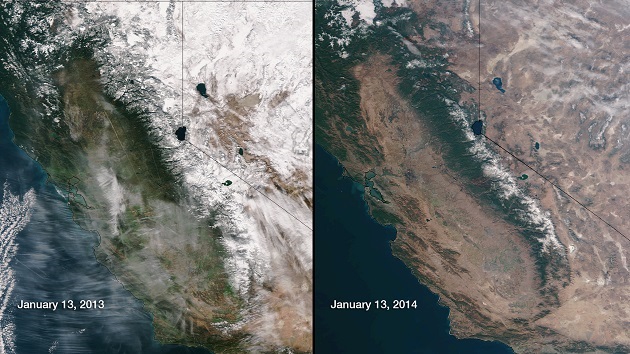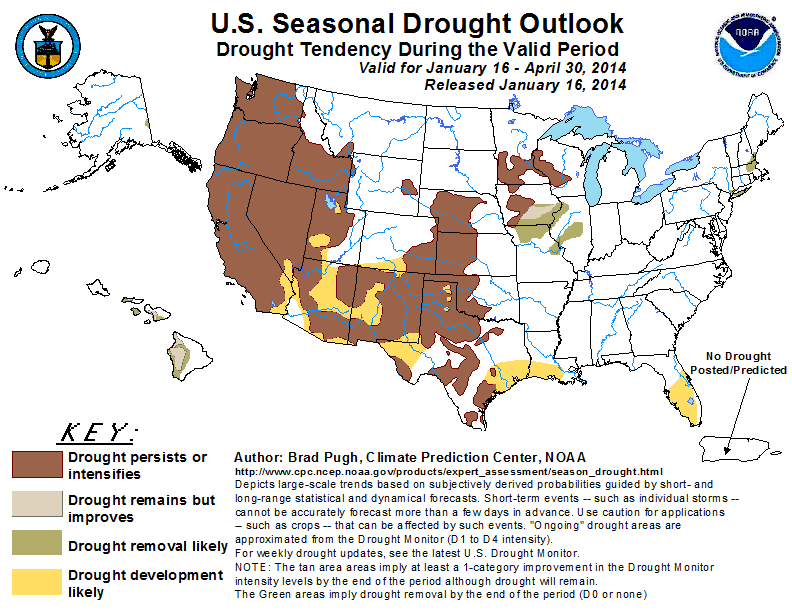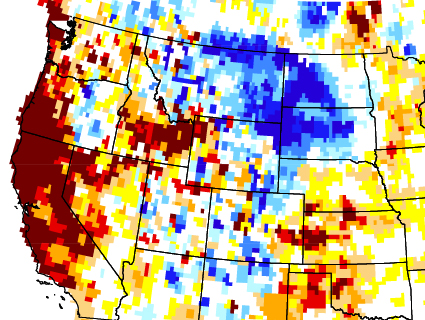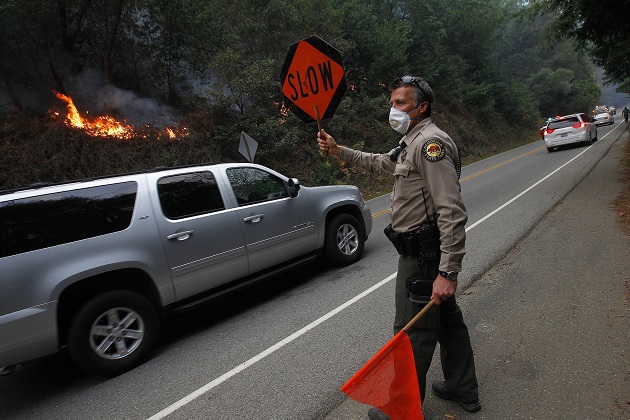
Satellite views of the Sierra Nevada, a year apart.<a href="http://www.nnvl.noaa.gov/MediaDetail2.php?MediaID=1483&MediaTypeID=1">NOAA/NASA</a>
“Fire season just didn’t end this year.”
The comment came from Scott Miller, the Los Angeles County fire inspector, in the wake of the Colby Fire in the foothills near Los Angeles. The fire is now 30-percent contained, but it serves as the latest reminder that California is facing an increasingly alarming drought—one that yesterday prompted Gov. Edmund Brown, Jr., to declare a state of emergency.
Last year was California’s driest on record for much of the state, and this year, conditions are only worsening. Sixty-three percent of the state is in extreme drought, and Sierra Nevada snowpack is now running at just 10 to 30 percent of normal. “We’re heading into what is near the lowest three year period in the instrumental record” for snowpack, says hydrologist Roger Bales of the University of California-Merced.
Water shortages, devastating wildfires, and growing economic impacts: All could be on the way unless more precipitation arrives, and fast. Here are some scary realities about the drought:
1. It’s Bordering on Unprecedented in Some Areas. According to Christopher Burt, weather historian at Weather Underground, the City of San Francisco has received only 2.12 inches of water so far in this water year. The driest water year on record was from 1850-1851, at 7.42 inches. So as of now, San Francisco is below half of the all-time record low.
2. Time in the Rainy Season is Running Out. California doesn’t get steady rain all year round. Rather, it has a rainy season each year, and we’re currently in it. Typically, the rainy season runs through March; if major precipitation doesn’t arrive by then, it probably won’t be coming. Granted, this is also the chief source of hope right now: California can sometimes get plenty of water in February and March.
3. The Drought Could Lead to Dirtier Energy Use. Peter Gleick, president of the Oakland-based Pacific Institute, points out one less-noticed consequence of the drought: The lack of water means less available hydropower. And that has consequences: “Because renewable hydropower is among the cheapest and most versatile of electricity sources,” writes Gleick, “California ratepayers will have to pay for more costly fossil fuels to make up for the difference.” The result, he notes, is likely to be “billions of dollars in added energy costs and generating more greenhouse gases to the atmosphere.”
4. It’s Setting the Stage for a Devastating Fire Season. Hotter, drier conditions favor wildfires. Indeed, California has already seen several significant fires since the October 31 end of the traditional fire season, including December’s Big Sur fire and the ongoing Colby Fire in the Los Angeles area. That’s a bad sign. So is the fact that in just the first 11 days of January, the state saw 154 fires that burned 598 acres. That’s way above the five-year average for this time of year.
For California, seven of the 10 largest fires in state history have occurred since the year 2000. And if these dry conditions persist throughout 2014, another new fire may be added to that list.
5. It Could Pummel Agriculture. California is an agricultural powerhouse. For crops, the state accounts for 15 percent of national sales and for livestock, 7.1 percent, according to the California Department of Food and Agriculture. But now farmers are likely to have considerably less water. This won’t lead to agricultural collapse, but it will definitely take a toll. “There will be, in agriculture, fewer plantings, fewer harvests, and revenue of seasonal crops,” says UC-Merced’s Roger Bales. “There could be more expensive pumping of groundwater. And there could be just lower yields if they have less water to apply.”
6. It’s a Sign of What’s to Come. NOAA’s seasonal drought outlook projects persistent or worsening conditions in California through April:

Over the longer term, climate projections suggest that this risk will continue or increase. According to the draft National Climate Assessment, the US Southwest—which includes California and five other states—can expect less precipitation, hotter temperatures, and drier soils in the future, meaning that by 2060, there could be as much as a 35-percent increase in water demand. Along with that comes a 25- to 50-percent increased risk of water shortages.
So even if California gets some much needed rain in the coming months, that’ll only be a short-term reprieve. Right now, the state needs to engage in some major climate adaptation planning, to get ready for a much drier future.












